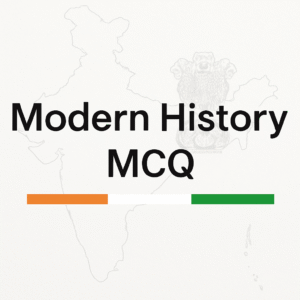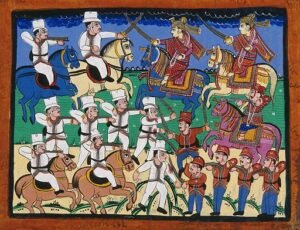Preamble of the Indian Constitution
Part 2 focuses on the deeper interpretation of the Preamble of the Indian Constitution, particularly the meaning of terms like Socialist, Secular, and Fraternity. It highlights the role of the Preamble in democracy, its goals, and its importance as the spirit of the Constitution. Readers will also learn about amendments to the Preamble and how justice, liberty, and equality form the foundation of India’s democratic framework.
Question 31: What does the term ‘Secular' in the Preamble of the Indian Constitution imply?
A. No state religion
B. The state can interfere in religious matters
C. The state can favor one religion
D. None of the above
Show Answer
Answer: A. No state religion
Question 32: The Preamble to the Indian Constitution declares India to be a Republic. What does it signify?
A. India has a monarch
B. India has a president as its head
C. India follows a dictatorship
D. India is governed by a foreign ruler
Show Answer
Answer: B. India has a president as its head
Question 33: Which of the following is explicitly mentioned in the Preamble of the Indian Constitution?
A. Equal Rights for All Citizens
B. Justice
C. Economic Development
D. Political Sovereignty
Show Answer
Answer: B. Justice
Question 34: The Preamble of the Indian Constitution was signed by how many people?
A. 300
B. 385
C. 499
D. 548
Show Answer
Answer: B. 385
Question 35: Which of the following is NOT part of the vision outlined in the Preamble?
A. Social Justice
B. Political Justice
C. Economic Justice
D. Cultural Justice
Show Answer
Answer: D. Cultural Justice
Question 36: The phrase ‘We the People of India' is significant in the Preamble. What does it indicate?
A. The Constitution is an act of the people
B. The Constitution is a legal document
C. The Constitution is an agreement among states
D. The Constitution is a decree from the government
Show Answer
Answer: A. The Constitution is an act of the people
Question 37: Which principle is established in the Preamble regarding the state?
A. The state should be a democracy
B. The state should be a monarchy
C. The state should be a republic
D. The state should be a dictatorship
Show Answer
Answer: C. The state should be a republic
Question 38: The term ‘Equality' in the Preamble of the Indian Constitution refers to which of the following?
A. Equal opportunity for all citizens
B. Equality before the law
C. Prohibition of discrimination
D. All of the above
Show Answer
Answer: D. All of the above
Question 39: The word ‘Fraternity' in the Preamble of the Indian Constitution promotes what?
A. National unity
B. International unity
C. Family welfare
D. Social equality
Show Answer
Answer: A. National unity
Question 40: Which of the following was added to the Preamble in the 42nd Amendment?
A. Secular
B. Socialist
C. Democratic
D. Republic
Show Answer
Answer: B. Socialist
Question 41: The Preamble of the Indian Constitution is a part of the Constitution. True or False?
A. True
B. False
Show Answer
Answer: A. True
Question 42: What does ‘Sovereign' mean in the context of the Preamble of the Indian Constitution?
A. India is under external control
B. India is independent and free from external control
C. India has a limited government
D. India follows an external policy
Show Answer
Answer: B. India is independent and free from external control
Question 43: The word ‘Justice' in the Preamble refers to which of the following?
A. Social Justice
B. Economic Justice
C. Political Justice
D. All of the above
Show Answer
Answer: D. All of the above
Question 44: The Preamble of the Indian Constitution mentions the term ‘Fraternity.' What does it signify?
A. National unity and solidarity
B. Family welfare
C. Equal rights for all
D. Political unity
Show Answer
Answer: A. National unity and solidarity
Question 45: Which of the following is NOT a value mentioned in the Preamble of the Indian Constitution?
A. Liberty
B. Equality
C. Fraternity
D. Solidarity
Show Answer
Answer: D. Solidarity
Question 46: The Preamble provides the framework for which of the following?
A. Fundamental Rights
B. Directive Principles of State Policy
C. Fundamental Duties
D. All of the above
Show Answer
Answer: D. All of the above
Question 47: Who among the following is credited with drafting the Preamble of the Indian Constitution?
A. Jawaharlal Nehru
B. Dr. B. R. Ambedkar
C. Rajendra Prasad
D. Sardar Vallabhbhai Patel
Show Answer
Answer: B. Dr. B. R. Ambedkar
Question 48: Which of the following is a part of the philosophy embedded in the Preamble of the Indian Constitution?
A. The belief in the rule of law
B. The promotion of communal unity
C. The establishment of economic equality
D. All of the above
Show Answer
Answer: D. All of the above
Question 49: What does ‘Democratic' in the Preamble mean?
A. The people elect their leaders
B. The government has power over the people
C. The government is formed by the military
D. The people have no say in governance
Show Answer
Answer: A. The people elect their leaders
Question 50: Which amendment of the Indian Constitution inserted the word ‘Secular' in the Preamble?
A. 42nd Amendment
B. 44th Amendment
C. 52nd Amendment
D. 62nd Amendment
Show Answer
Answer: A. 42nd Amendment
The deeper understanding of the Preamble of the Indian Constitution reveals its enduring significance in shaping India’s democracy. The inclusion of terms like Socialist, Secular, and Fraternity ensures that the Constitution addresses the diverse needs of its people. As the spirit of the Constitution, the Preamble continues to guide laws, policies, and interpretations, ensuring the fulfillment of its goals of justice, liberty, and equality.
Related Post:
MCQs on Preamble of Indian Constitution—Part 1
MCQs on Preamble of Indian Constitution—Part 3







